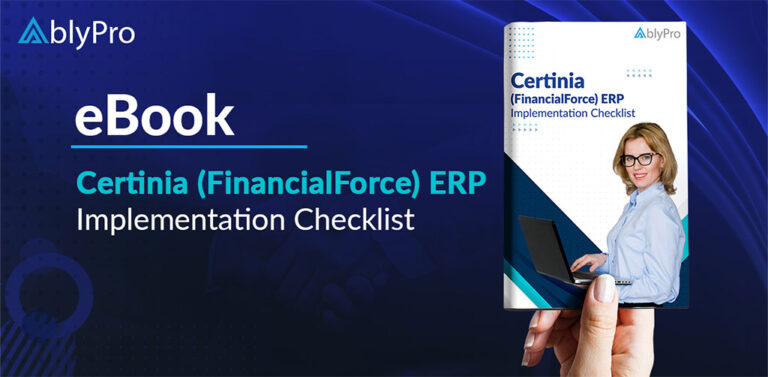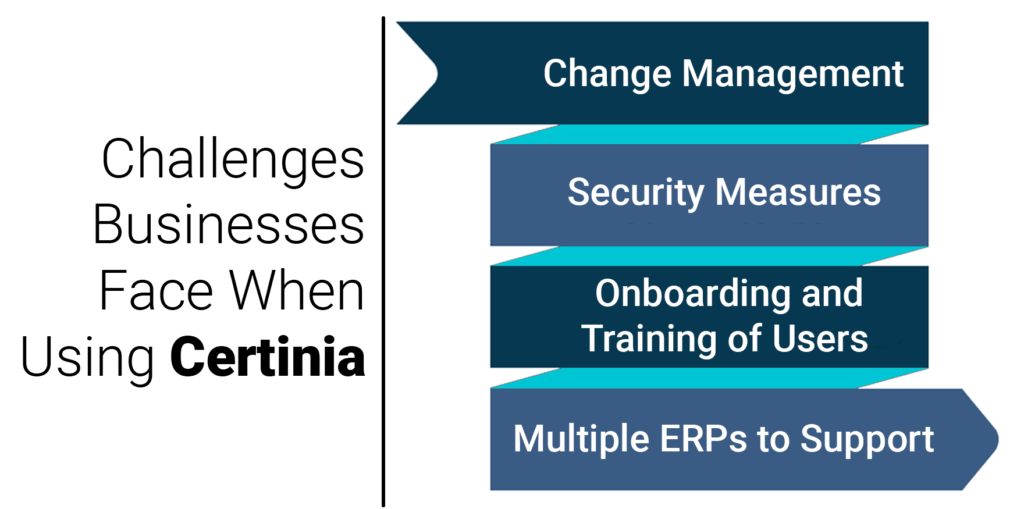The current market is undergoing changes faster than ever. What this means is that it exposes flaws in static business models and forces every organization to constantly combine revenue streams from products, subscriptions, and a wide range of other services. Businesses that thrive can quickly recognize new opportunities and anticipate shifting expectations. All it needs is a dependable ERP system that enables your organization to adapt to consumer needs. In this blog, we will talk about what is an ERP exactly, how it benefits your business, and what Certinia’s ERP platform brings to the table.
What Is ERP (Enterprise Resource Planning)?
In layman’s terms, enterprise resource planning (ERP) refers to a solution that automates your company’s “back-office” procedures, such as accounting and financial reporting, project management, billing, human resources, and supply chain operations. An ERP’s primary purpose is to optimize and automate these operations to increase operational efficiency and company profitability.
Certinia’s (FinancialForce) ERP Platform – What it Offers & Who is it for?
The ability of the Certinia ERP system to optimize all business activities is what genuinely sets it apart. In layman’s terms, an ERP system is a complete corporate mobility and growth solution that includes a variety of features. There are several functional areas in Certinia ERP solutions that include:
- Financial Management.
- Order & Inventory Management.
- Revenue Management.
- Procurement.
- Governance, Risk, and Compliance (GRC).
- Supply Chain Management.
- Analytics & Reporting.
Why Choose an Certinia ERP System for your Organization?
In today’s world, a company’s ability to reduce errors is more important to maintain acceptable levels of competitiveness: consequently, the fundamental goal of ERP systems is to properly assist this optimization problem. Here’s what an ERP system enables:
- Real-time visibility in operations: There is more openness and visibility in your distribution systems for more exact order processing.
- Cost control and Inventory: Inventory and cost control are simplified thanks to different costing techniques, tiered pricing, and series tracking.
- Complete financial control: You can get access to tools for integrated cash flow management, accounting, accounts payable and receivable, and reporting.
- Efficient assembly and distribution: It includes pre-purchases, pickup, and packing, customized prices, stocks, and orders.
- Data mining and real-time access to business performance data: It includes processes like forecasting, budgeting, analyzing, and reporting.
- Customer experience and satisfaction optimization: You can optimize customer experience and satisfaction with sales statistics, conversation follow-up discussions, and clients’ histories.
Learn More: Certinia ERP vs. Accounting: Basic Differences Explained
Top 4 Benefits of Implementing Certinia ERP for Your Business

1. Streamline Front and Back Office Operations
You must be able to handle the full customer lifecycle on one system to establish a business that supports client retention. Connecting your back-office processes (ERP)—specifically, financials, billing, and product and service delivery—to your front office (CRM) allows you to develop a holistic perspective of your consumers.
With contemporary ERP, everyone–sales, finance, service delivery, support, and beyond–has real-time access to all the critical customer information. Instead of waiting days or weeks for teams to catch up, everyone from sellers to accountants can work with the same view of crucial customer data.
2. Innovative Services and Subscription Models
Customers today want your business models to always suit their needs. A modern ERP system, designed for service-centric businesses, is adaptable enough to allow you quickly change your products to support subscription-based contracts, complex contracts, or a mix of business models.
3. Provide Complete Business Transparency
A contemporary ERP helps users to make better-informed decisions based on future impact and profitability, linking individual and team activities to overall business goals. Instead of guessing, know when to profit on product upgrades or cross-sells, or which clients require aggressive engagement to prevent attrition.
By providing your front and back-office staff with a more unified, continuous lens across the client lifecycle, you can make your organization more visible, data-driven, and forecastable.
4. Improved Accounting and Tax Management
Technology is without a doubt a great and effective ally for businesses. ERPs, which optimize the accounting and tax management of the business, end up validating this statement! With the massive amount of information that managers must deal with daily, completing this task without the assistance of company management software is nearly impossible.
We live in a world with heavy taxation; thus, businesses must implement measures to decrease expenses with various taxes. It is feasible to automate controllership by deploying an ERP management system, eliminating failures connected to fines, tax authorities, and other expenses.
For many medium-sized and large businesses, ERP is crucial because it can gather and store accounting and tax information with greater security.
Explore, the best practices included for Efficient ERP Implementation.
Top 5 Questions to Ask Before Implementing Certinia ERP
The most valuable action a company can do is to choose, implement, and manage an ERP platform. However, the implementation process is simple, especially if the organization has the technical expertise required to successfully launch an ERP platform. This is why many businesses seek the assistance of vendor-specific ERP implementers and consultants. Here we have compiled a list of questions that you can ask your ERP consultant.
- Will operations be standardized on a single platform without compromising functionality or productivity? Will any operations continue to be run independently?
- How will the suppliers migrate my data with the least amount of disturbance to my business and the best overall efficiency?
- Do the vendors have previous experience in my industry?
- What are the prices of the stand-alone solutions? What is the cost of integration and continuous maintenance?
- Do I require the integration functionality, or can I get by with an out-of-the-box ERP solution?

What is the Perception of Cloud ERP by Industry or Company Size?
In a few years, cloud ERP solutions have become extremely popular, depending on the company size and industry. Smaller businesses are frequently more amenable to cloud ERP solutions because they are seeking a method to replace their old and rigid software. Enterprise-level firms, on the other hand, are not necessarily as enthused about cloud ERP solutions due to a lack of functionality, excessive rates, and inadequate services. However, the industry is evolving, with more and more businesses opting for Cloud ERP because to its flexibility, scalability, and low total cost of ownership.
Free eBook
Certinia (FinancialForce) ERP Implementation Checklist

This eBook Will Cover
- The right approach to Certinia ERP Implementation.
- Steps of ERP Implementation – Pre-planning, Consulting, Training, Pilot, Go Live, and Maintenance processes.
- How ERP Implementation can guarantee your business success?
- Learn about Specific details within every step to ensure you give your business the best chance to reap the full benefits of the platform.
Challenges Businesses Face When Using Certinia (FinancialForce) ERP

1. Change Management
Change management is a vital component of every business transformation, and it can be one of the most difficult obstacles to overcome when transitioning to a full cloud ERP solution. The majorities of people are content with their current routine and would naturally reject any change that interrupts it. It is critical to overcome this opposition by demonstrating how the new system would improve things. This entails more than simply stating that it will be current and new; you must outline how the new system will benefit them in terms of efficiency, cost savings, increased customer service, and so on.
2. Security Measures
Security is a critical consideration since sensitive data can be readily compromised if modern security measures are not in place. This is especially true for remote resources like employees and their workstations. It is critical to understand the risks and take the appropriate precautions to keep the data secure.
There are numerous approaches to this problem. Companies can tackle the task on their own, employ a consultant, or collaborate with their implementation partner to determine the best methodology for their individual instance.
3. Onboarding and Training of Users
User onboarding and training are critical components of every successful organization. Employees are unable to perform their responsibilities successfully and efficiently unless they receive sufficient training. Unfortunately, many businesses underinvest in this activity, viewing it as a waste of money when staff depart and take their training with them. This is a deadly error with major ramifications for the company’s bottom line.
The greatest method to assure good user onboarding and training is to ensure that the money for it is enough and secure.
4. Multiple ERPs to Support
At the start of an ERP project, organizations often install modules from the same ERP vendor. However, as the process progresses, organizational requirements grow, and businesses frequently find themselves purchasing modules from many vendors. Not only must the company modify its existing linkages with other apps, but it must also allow data translation to and from a variety of new data formats. If the existing integrations are closely connected, modifying them becomes costly and brittle.
How AblyPro Can Help?
ERP system is known to be the backbone of commercial sector and relying on its benefits can yield positive outcomes for a firm to become more competitive and versatile. The company will begin to adapt to its customers rather than the other way around.
At AblyPro, we take pride in our expertise to implement and manage Certinia (FinancialForce) ERP solutions. Our skilled staff has been supporting several organizations and achieving success for our clients. Schedule a meeting to learn more about what Certinia ERP can achieve for your company.
Author

Project Manager, AblyPro
Manish Maid is a FinancialForce Project Manager at AblyPro with deep technical expertise in handling Enterprise Resource Planning software for optimizing Financial Management, Account Receivables, Account Payables, and other finance functions. With over 25 years of experience in training, implementation, business accounts and operations management, Manish enables organizations to simplify and streamline accounting complexities to optimize business processes while improving operational efficiency and boosting customer satisfaction.





